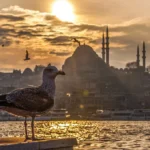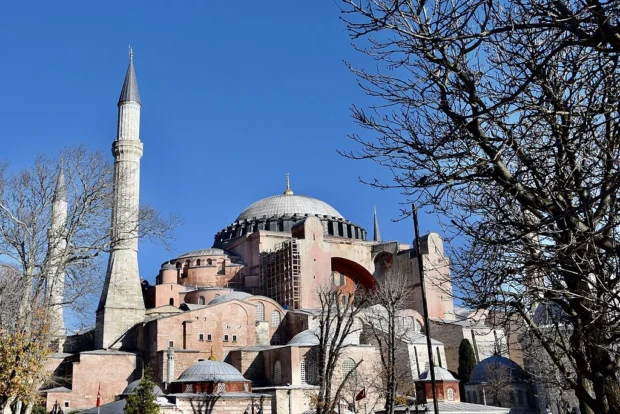In the heart of Istanbul, the Hagia Sophia stands as a grand emblem of Turkey’s rich cultural tapestry and architectural genius. This magnificent structure, blending Byzantine artistry with Ottoman grandeur, beckons curious visitors captivated by history, art, and spiritual legacy. Whether arriving from Istanbul Airport or Sirkeci station, reaching Hagia Sophia is straightforward, making it an unmissable highlight for anyone drawn to the city’s ancient layers. Surrounded by vibrant bazaars and traditional eateries, the area offers a sensory immersion into Istanbul’s everyday pulse.
Table of Contents
Approaching a Monument of Time and Faith
Located in Sultanahmet Square, the Hagia Sophia is easily accessible and perfectly nestled within Istanbul’s historic peninsula. From Istanbul Airport, a direct shuttle to Taksim followed by a short tram transfer to Sultanahmet station provides a comfortable journey. Travelers arriving by train into Sirkeci station can enjoy a scenic walk or take tram line T1, which stops right by the monument. The proximity to the Blue Mosque and Topkapi Palace makes this neighborhood a hotspot for those passionate about layered heritage and architectural evolution.
If you find Hagia Sophia fascinating, the Blue Mosque nearby offers a stunning glimpse into Ottoman art and peaceful worship spaces.
Nearby Stays and Dishes to Savor
Accommodations ranging from charming guesthouses to boutique inns cluster around Sultanahmet, offering visitors easy access to the Hagia Sophia as well as the aromatic spices and mouthwatering kebabs of local eateries. For an authentic taste of Istanbul, sampling freshly baked simit from street vendors or indulging in a plate of succulent lamb kebabs at a nearby meyhane is highly recommended.
An Emblematic Tale: Hagia Sophia’s Historical Pulse
Originally constructed in 537 CE as a cathedral by Emperor Justinian I, Hagia Sophia was the world’s largest church for nearly a thousand years. Its grand dome, an architectural marvel of its time, symbolized heaven on earth and reflected a nuanced synthesis of structural ingenuity and artistic splendor. Following the Ottoman conquest in 1453, it was transformed into a mosque, with minarets added, illustrating the city’s cultural shifts and religious convergence. Now functioning as a museum and place of worship, this site embodies Istanbul’s complex identity as a crossroads of civilizations.
Planning Your Visit: Essential Tips and Insights
To fully appreciate Hagia Sophia’s grandeur, visit early on weekdays when crowds are thinner and the morning light illuminates the mosaics vividly. Avoid weekends and religious holidays when local worshippers gather in larger numbers. Tickets can be purchased onsite, but to bypass lines and enjoy guided narratives on the mosaics, mosaics, and calligraphic panels, reserving a tour online is advisable.
Reservation and Tour Recommendations
Guided tours provide nuanced insight into Hagia Sophia’s architectural feats and symbolisms, enhancing the visitor experience. Expect to spend at least two hours wandering through vast halls adorned with intricate mosaics, marble pillars, and Ottoman calligraphy. Booking online through the official site before arrival ensures a smooth entry and adds the opportunity for specialist tours focusing on archaeology and restoration practices.
Beneath the Dome: Architectural and Artistic Marvels
Walking beneath Hagia Sophia’s dome, one encounters a harmony of light and space crafted from massive stone blocks and delicate mosaics. What often escapes first-time visitors is the subtle interplay between Christian iconography and Islamic motifs, revealing layers of religious dialogue over centuries. The stone architecture showcases not only aesthetic considerations but sophisticated engineering solutions – the buttresses, arches, and the dome’s pendentives cleverly distribute weight to achieve a seemingly floating canopy.
Neighborhood Rhythms: Markets and Crafts Nearby
Beyond the walls of Hagia Sophia, the Sultanahmet neighborhood buzzes with traditional markets and street vendors offering ceramics, textiles, and handcrafted souvenirs echoing centuries-old craftsmanship. Whether browsing for finely embroidered textiles or hand-painted ceramic tiles, visitors can connect with Istanbul’s enduring artisanal heritage. Nearby, the spice market lends the air of exotic aromas, inviting contemplations of Istanbul’s historical role as a key trading hub on the Silk Road.
Respecting the Past, Living the Present
Hagia Sophia is not merely a monument frozen in time; it is a living symbol of Istanbul’s ongoing story. Reflecting on its transformation from cathedral to mosque and museum, one appreciates the endurance of cultures and the persistence of faith. Visitors are gently reminded to respect its sanctity regardless of their background, embracing the monument as a shared legacy of humanity’s architectural and spiritual quests. A leisurely afternoon spent seated in Sultanahmet Square, watching the interplay of sunlight and shadow on the Hagia Sophia’s façade, is a perfect conclusion to a day steeped in history and present-day vibrancy.
For current visitor information, ticket prices, and guided tours, visit the official Hagia Sophia website, a thoroughly designed resource for preparing your visit.

Explorer of historical towns, ancient ruins, and traditional markets, combining modern travel with interest in heritage.
